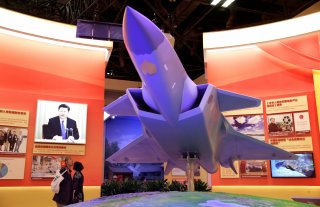China's J-20 Stealth Fighter: Really a Threat?
Several previous reports cite production problems and delays with initial J-20 manufacturing, particularly centered around the J-20’s “high-thrust turbofan WS-15 engine.” A report from the South China Morning Post says J-20 engine work has “fallen behind schedule.”
Here's What You Need To Remember: If China has in fact produced fifty of its highly touted J-20, that still falls way short of America’s current fleet of ready and armed fifth-generation fighters.
China’s new fifth-generation J-20 stealth fighter has formally entered production, marking a new phase with the country’s efforts to rival the U.S.-built F-35 and position itself as a rival major power air force.
(This article first appeared in July 2020.)
Previous reports had speculated that China had possibly built as many as fifty in 2019, however, statements about engine problems may have caused some delays. A new report from the South China Morning Post says China formally began “mass production” of an upgraded J-20B stealth fighter, marking the event at a formal unveiling ceremony, according to the report. Of course, it is not yet clear just how many J-20s China will build, or how fast they plan to build them. Nonetheless, slower or smaller scale J-20 production by no means erases or largely minimizes the growing threat presented by China’s Air Force.
While debates and uncertainties continue to swirl around how agile, lethal, stealthy and advanced China’s J-20 stealth fighter may be, the country may simply have another challenge crippling its ability to rival the F-22 and F-35: there simply are not enough J-20s.
If China has in fact produced fifty of its highly touted J-20, that still falls way short of America’s current fleet of ready and armed fifth-generation fighters. Lockheed statements given to The National Interest report that the firm has built and delivered 195 F-22s, with 186 of them combat-ready. Made by Lockheed Martin and Boeing, the F-22 uses two Pratt & Whitney F119-PW-100 turbofan engines with afterburners and two-dimensional thrust vectoring nozzles, an Air Force statement said. It is sixteen-feet tall, sixty-two-feet long, and weighs 43,340 pounds. Its maximum take-off weight is 83,500 and there is an ongoing and interesting discussion comparing F-35 and F-22 engine thrust to China’s J-20 engine.
As for the F-35, available Lockheed data says it delivered its 134th F-35 last year and, at least prior to the coronavirus, planned to deliver as many as 141 F-35s this year. The coronavirus, however, has impacted supply chain and production progress with the F-35, and Lockheed officials recently told Air Force Magazine that they expect to decrease aircraft production by eighteen-to-twenty-four jets.
There are also reports that the apparent design similarities between the J-20 and the F-35 may indeed be a result of espionage, according to a 2018 Pentagon news story about DoD’s annual China report. A cursory look at the J-20 does appear to show some resemblance to the F-35, particularly the blended wing-body front end and internally built, conformal exhaust pipes. Meanwhile, the J-20 has a wider and longer lower-body. However, available photos show an even larger measure of similarity between the F-35 and Chinese J-31 multi-role fighter.
Several previous reports cite production problems and delays with initial J-20 manufacturing, particularly centered around the J-20’s “high-thrust turbofan WS-15 engine.” A report from the South China Morning Post says J-20 engine work has “fallen behind schedule.” However, it certainly remains feasible that any production or engineering challenges have been addressed and rectified, clearing the way for larger-scale manufacturing. Furthermore, it is entirely possible that China could eventually build a very large fleet of J-20s, and ultimately produce a force designed to more fully rival the F-35.
Kris Osborn is the new Defense Editor for the National Interest. Osborn previously served at the Pentagon as a Highly Qualified Expert with the Office of the Assistant Secretary of the Army—Acquisition, Logistics & Technology. Osborn has also worked as an anchor and on-air military specialist at national TV networks. He has appeared as a guest military expert on Fox News, MSNBC, The Military Channel, and The History Channel. He also has a Masters Degree in Comparative Literature from Columbia University.
Image: Reuters

